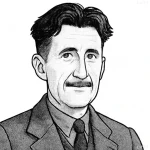“I’m fat, but I’m thin inside… there’s a thin man inside every fat man.”

- June 25, 1903 – January 21, 1950
- Born in India during the British colonial period
- Author, journalist
table of contents
Quote
“I’m fat, but I’m thin inside… there’s a thin man inside every fat man.”
Explanation
In this quote, George Orwell uses the metaphor of being “fat” on the outside but “thin” on the inside to reflect on the internal conflicts and contradictions that can exist within an individual. The “fat” represents outward appearances, social roles, or external conditions—such as physical size, social status, or superficial qualities—while the “thin man inside” represents the true self, the core of a person that may be invisible or concealed beneath layers of external pressure, expectations, or even personal insecurities. Orwell suggests that despite external appearances, everyone has an inner identity or essence that is different from the public face they present to the world.
Orwell’s use of this metaphor may also be a reflection on the self-awareness and frustrations that come from living in a society where individuals are often judged by superficial criteria—whether it’s their physical appearance, economic status, or social role—while their true personal experiences and inner lives remain unseen. It might also reflect the internalization of conflict within the self, where an individual’s true nature is at odds with how they are perceived or expected to behave in society.
This concept is relevant today, especially in the context of body image, social expectations, and identity. In an era where appearance often carries significant social and cultural weight, people may feel pressure to conform to societal standards, which can mask or obscure their inner selves. Orwell’s metaphor encourages us to recognize the complexity of identity and the disconnect that can exist between external appearances and the internal truths of an individual. It also serves as a reminder to look beyond the surface and appreciate the hidden depths and complexities of people, recognizing that there is more to a person than what meets the eye.
Would you like to share your impressions or related stories about this quote in the comments section?

